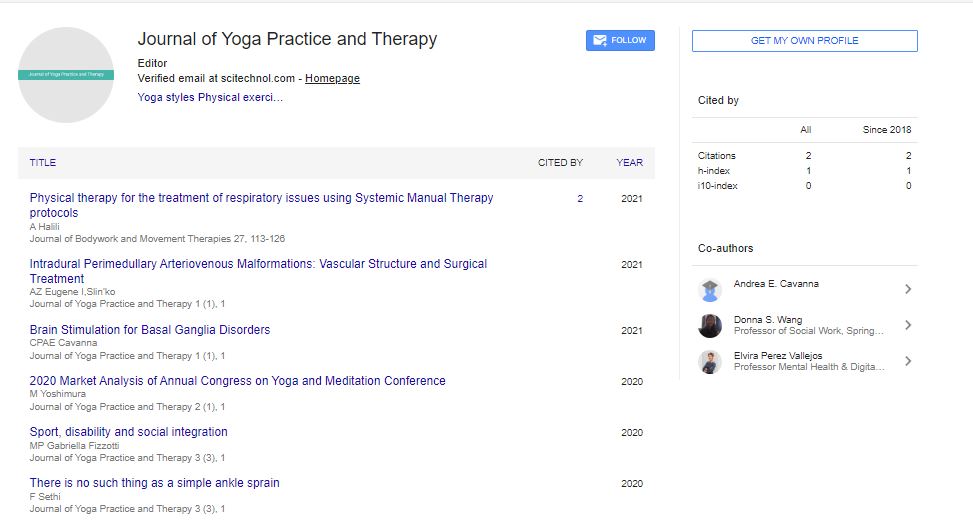Opinion Article, J Yoga Pract Ther Vol: 5 Issue: 2
Yoga's Impact on Cricket Bowlers' Performance and Fitness
Bela Rajani Danielle*
Department of Medicine All India Institute of Medical Science, Rishikesh, Uttarakhand, India
Corresponding Author: Bela Rajani Danielle
Department of Medicine All India Institute of Medical Science, Rishikesh, Uttarakhand, India
E-mail:BelaRajani6477@gmail.com
Received date:01 March, 2022, Manuscript No. JYPTY-22-58238;
Editor assigned date: 03 March, 2022, PreQC No. JYPTY-22-58238 (PQ);
Reviewed date: 14 March, 2022, QC No JYPTY-22-58238;
Revised date: 21 March, 2022, Manuscript No. JYPTY-22-58238 (R);
Published date: 29 March, 2022, DOI: 10.4172/Jypty.100096
Citation: Bela Rajani Danielle (2022) Yoga's Impact on Cricket Bowlers' Performance and Fitness. J Yoga Pract Ther 5:2.
Keywords: Yoga styles, Physical exercises, Meditation, Mindfulness, Prenatal yoga Physiotherapy
Description
Justice-bowling performance is known to be told by speed of ball release and delicacy. Presently, training sessions generally involve fielding-specific drills and conditioning exercises. Scientific substantiation for addition of a comprehensive yoga intervention in diurnal training and exercise sessions remains unexplored. The present study explored the effect of yoga on bowling performance and physical fitness in justice bowlers. Sports fitness testing and training were conducted among 60 non-elite recreational- club manly justice players aged. Justice-bowling speed was e evaluated using a speed radar gun, delicacy with a test developed by cardiorespiratory abidance using the yo-yo intermittent recovery test, lower- extremity and box strength using a back- leg dynamometer, upper- branch power using a drug ball gamble test, power using a perpendicular- jump test, and inflexibility using a sit and reach test. In addition to bowling practice, the yoga intervention group performed pranayama and standing and prone asana, whereas the control group rehearsed conventional exertion exercises, for 45 twinkles/ day, three times a week, for 12 weeks. Enhancement in bowling speed, delicacy, cardiorespiratory abidance, muscle strength, and inflexibility were similar between the two groups. Statistically significant advancements in birth scores in bowling speed, delicacy, cardiorespiratory abidance, muscle inflexibility, strength, and power were similar between the two groups of non-elite manly justice players. Bowling speed bettered by 6.52 in the yoga group and by 5.18 in the control group. Bowling delicacy bettered by 35.40 in the yoga group and by 31.29 in the control group. Fresh exploration on long- duration intervention in elite players may help to establish the part of yoga in conventional justice-bowling training.
Freiburg Mindfulness Inventory
The current study examined whether yoga would increase situations of awareness in a healthy population. System Forty-six actors were aimlessly assigned to an 8-week yoga intervention group or a delay-list control group. Awareness was assessed pre and post yoga, using the Freiburg Mindfulness Inventory. Results indicate that the yoga group endured a significant increase in Overall awareness, and in three awareness subscales; Attention to the present moment, Accepting and open stations toward experience, and Perceptive understanding (p<.01). The control group endured a significant increase in overall awareness (p<.02) and perceptive understanding (p<.01). Findings suggest that a yoga intervention may be a feasible system for adding situations of particularity awareness in a healthy population, potentially entwining yoga as a preventative system for the after development of negative emotional mood countries. The control group also endured moderate elevations of awareness at the alternate assessment. The present study aimed to interpret how fat adolescents respond to a multicomponent program approach on body composition, physical fitness, and seditious labels, using aquasi-experimental study with 33 rotundity adolescent's intervention group. The intervention comported of 24 weeks with physical exercises and nutritive and cerebral guidance. Both groups were estimated at the pre/post-intervention moments on body mass indicator abdominal strength, inflexibility; leptin; interleukin 6 interleukin 10 and excrescence necrosis factor nascence. Mixed- analysis of friction and generalized estimation equations were used for statistical analysis between asker's and on-responders with CRF in the IG. There was a positive effect on body composition, physical fitness, and leptin. In addition, reductions in body composition parameters were explained by CRF advancements.
Cardiorespiratory Abidance
Sedentary life style leads to rotundity which related into deterioration of cardiac function, and deconditioning on musculoskeletal system, particularly on walking function. Walking is an important activity in mortal life that automatically repeated in diurnal exertion. Doing exercise by walking exertion is a simple and safe exercise. Still, in walking exercise tradition, we need to establish what the ideal to achieve is. The ten thousand way of Walking Program is pedometer- grounded walking program begin in Japan for adult and senior, therefore the goods in rotundity adolescent remains unclear. The aimed of this study was to find the effect of SWP in Cardiorespiratory Abidance on fat adolescent. This study was pre and post aimlessly experimental design with control, in 24 high academy obese adolescent. Subjects divided into two groups, the intervention group that entered way walking program5 days in a week for 6 weeks, and the control group that number of step walking recorded by a pedometer without diurnal target. The cardiorespiratory abidance was estimated by the six nanosecond walking test, that measured ahead and after intervention. Results The Intervention and control groups each contain 12 fat high academy scholars that equal in age, body mass indicator, and the mean number of walking way per day in treatment group. The SWP has proven adding the cardiorespiratory abidance of fat adolescent. Physical exercise reduces the biochemical labels of rotundity, but the goods of multicomponent interventions on these labels should be explored.
 Spanish
Spanish  Chinese
Chinese  Russian
Russian  German
German  French
French  Japanese
Japanese  Portuguese
Portuguese  Hindi
Hindi 